- For the earlier front engined bus, see Leyland Titan (front engined double-decker).
| Leyland Titan (B15) | |
|---|---|
 Leyland Titan B15 prototype 05 (BCK 706R). | |
| Manufacturer | British Leyland/Leyland Bus |
| Built at |
Park Royal Vehicles Workington, England |
| Operator(s) |
London Transport Reading Transport and others |
| Specifications | |
| Length | 9.56m |
| Floor type | Step entrance |
| Doors | 1 or 2 door |
| Chassis | (Integral) |
| Engine(s) | Gardner/Leyland |
| Options | Various customer options |
The Leyland Titan was a model of double-decker bus produced by the Leyland Truck & Bus division of British Leyland from 1977 until 1984, almost exclusively for London Transport.
Development[]
The Titan was first conceptualised in 1973 as project B15 and was intended as a replacement for the Leyland Atlantean, Daimler Fleetline and Bristol VRT. Following the success of the single-deck Leyland National, it was decided from the outset that the vehicle would be very standardised and of integral construction. This allowed more flexibility in the location of mechanical components and allowed a reduced step height. The move away from body-on-chassis construction caused concern for the bodybuilders who had already lost market to the Leyland National. Talks regarding licensing agreements were held with Alexander and Northern Counties, both major suppliers to their respective local markets, but no agreements were reached.
London Transport was seen as a major market and so the specification was heavily influenced by London preferences. London Transport was suffering problems with its DMS class of Daimler/Leyland Fleetline one-man-operated double-deckers and wanted rather more input into the design than they had had with the DMS. Leyland too wanted to gain more operator input than had been the case with the Leyland National.
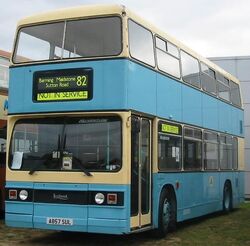
Former London Transport Titan T857 (A857 SUL), with Nu-Venture, painted in centenary Maidstone Corporation Transport fiesta blue livery.
Five prototypes (B15.01-B15.05) were constructed in 1975-1977, two of which were evaluated in London.
Specification[]
The Titan was offered as one size — 9.56 m long by 2.50 m wide by 4.4 m high. The main body structure was aluminium and the body was assembled using 'Avdelok' rivets similar to the Leyland National. Single-door or dual-door layouts were offered, with a number of options for the location of the staircase. Mechanically, independent front suspension and a drop-centre rear axle were used, with air suspension and power hydraulic brakes as standard. The prototype engine was a turbocharged version of the Leyland 500 series, although this was changed to Gardner 6LXB for production as a result of customer preference and concerns over fuel economy and reliability of the 500 series. The Leyland TL11 engine was available for later production versions. The engine was mounted vertically at the rear, with the radiator located separately in a compartment above the engine. This led to an unusual off-centre square rear window. The overall design was advanced for the time and improved on noise and emission requirements by considerable margins.
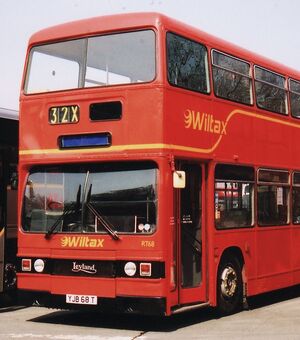
A Leyland Titan with the more rare Park Royal bodywork, owned by Wiltax.
Production[]
The Titan name, previously used for a front-engined double-decker, was revived for production in June 1977. It was intended that the first one hundred vehicles would be built at Park Royal Vehicles, with production switching to AEC in Southall. This caused industrial relations difficulties at Park Royal and some 200 skilled craftspeople left. Production was very slow and the first vehicle was not delivered until August 1978. In October 1978, Leyland announced the AEC factory would close, with the intent of keeping Titan production at Park Royal. The very slow production rate continued, causing cancellation of a number of existing orders. The industrial relations problems continued as Leyland sought to replace the skilled staff who had left with semi-skilled workers. Finally, Leyland announced in October 1979 that Park Royal would close in May 1980. Once this decision had been made and a productivity-related redundancy package negotiated, production increased dramatically. The final 150 Park Royal vehicles were built in seven months, while the first 100 vehicles had taken fourteen months. After initial efforts to transfer production to ECW in Lowestoft failed, again due to industrial relations problems, it was finally decided that production would recommence at an expanded facility in Workington, which also built the Leyland National. It took almost a year to expand the facility, transfer the jigs and tooling from Park Royal and recommence production. The continued delays caused the loss of further orders.
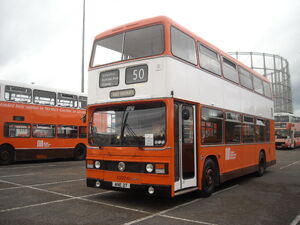
One of 15 Titans purchased by Greater Manchester Transport against an order of 190. ANE 2T is preserved by the SELNEC Preservation Society and seen here at Sportcity, Manchester during the SELNEC 40 event in October 2009.
Besides the production difficulties, other aspects of the Titan specification, which was strongly influenced by London Transport, were unpopular. Power hydraulic brakes, a fixed height of 14 ft 5 in and an inability to specify local bodywork all limited Titan's appeal. Outside of London, fifteen were purchased by Greater Manchester PTE (against an original order of 190) and five by West Midlands PTE (against an original order of 80) which were later sold to London Transport. The 1978 British Motor Show at the National Exhibition Centre in Birmingham featured the first vehicles for both operators. Reading Transport took two Park Royal Titans to full London specification and a further ten from Workington, five of which featured high ratio rear axles and coach seats for express services into London. One vehicle was exported to Hong Kong and became China Motor Bus's TC1 (CD1213). A 36ft long version of the Titan had been planned for this operator but that too was cancelled as a result of the difficulties at Park Royal and two Leyland Victory Mk2s were built instead. A demonstrator built in 1982 failed to secure any further orders, operators preferring the flexibility and lower cost of the Leyland Olympian. This vehicle (registered VAO 488Y) was eventually sold to a Scottish independent operator, Ian Glass of Haddington.
London's orders were being split between the Titan and the MCW Metrobus but production of Titan for London only was proving uneconomic. Strong pressure was brought to bear to increase the Titan share of the London orders. As a result, Leyland received the entire order for 275 vehicles in 1982. This led to layoffs at MCW. The 1983 order also favoured Leyland, with 210 Titan and 150 Metrobus. The decision was made to end production upon completion of a final batch of 240 ordered in 1984. The final Titan, London Transport T1096, entered service in October 1984.
The Titan in London[]
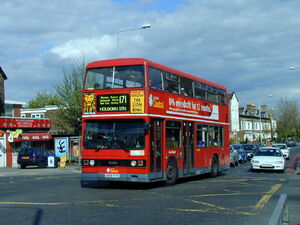
London Central-owned Leyland Titan T991 (A991 SYE) at Forest Hill on route 171, 5 May 2001.
The orders from London Transport were as follows:
- 1979: 100 (T1-100)
- 1980: 150 (T101-250) - reduced from 250 due to industrial relations difficulties at Park Royal.
- 1981: 150 (T251-400)
- 1982: 275 (T401-675)
- 1983: 210 (T676-885)
- 1984: 240 (T886-1125)
The first production Titans were delivered in August 1978 and entered service from Hornchurch in December 1978 on routes 165, 246 and 252. The Titan's London Transport service career saw it working in the eastern and south eastern half of the capital, though a surplus of the type following tendering reverses in the later 1980s saw Ts spread to some northern garages. Withdrawals began in December 1992, with large numbers passing to other operators, including Merseybus, Oxford and Kinch. Further buses remained on London work under the ownership of independent contractors like London Suburban Buses, London & Country, BTS and London Coaches (later Atlas Bus).
Upon the privatisation of the London Buses Limited subsidiaries, the remaining Titans fell between London Central, Stagecoach East London and Stagecoach Selkent. The latter pair began cascading their Titans away almost immediately, spreading them throughout the country. Stagecoach East London's last Titans operated in September 2001 and Selkent's were withdrawn in November 2001, leaving London Central with a small number of spare buses which were eventually whittled down. Amid a small ceremony, the last one, T1018 was retired from the 40 on 19 June 2003.
The Titan today[]
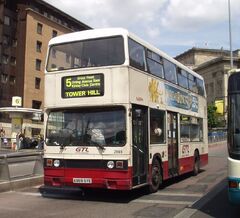
A Leyland Titan operated by Glenvale Transport, in Queen Square Bus Station, Liverpool.
The Low Emission Zone saw off the last Blue Triangle and Sullivan Buses Titans.
Outside London, just a few now remain in service, particularly with independents - MASS Engineering in South Yorkshire and Nu-Venture in Kent have substantial fleets. However, Stagecoach Group, who inherited a large number of the type from its purchases of East London and Selkent in 1994, only has a handful left in service, in use as school buses with Stagecoach West Scotland.
References[]
- Jack, D; (1984). Leyland Bus Mk2. The Transport Publishing Company. ISBN 0-903839-67-9
- Jack, Doug; (1994). Beyond Reality - Leyland Bus - the twilight years. Venture publications. ISBN 1-898432-02-3
External links[]
- London's Leyland Titan Breathes Its Last - The London Bus Page, 19 June 2003
- London's Titans - Where they are now
| ||||||||||||||
| This page uses some content from Wikipedia. The original article was at Leyland Titan (B15). The list of authors can be seen in the page history. As with Tractor & Construction Plant Wiki, the text of Wikipedia is available under the Creative Commons by Attribution License and/or GNU Free Documentation License. Please check page history for when the original article was copied to Wikia |